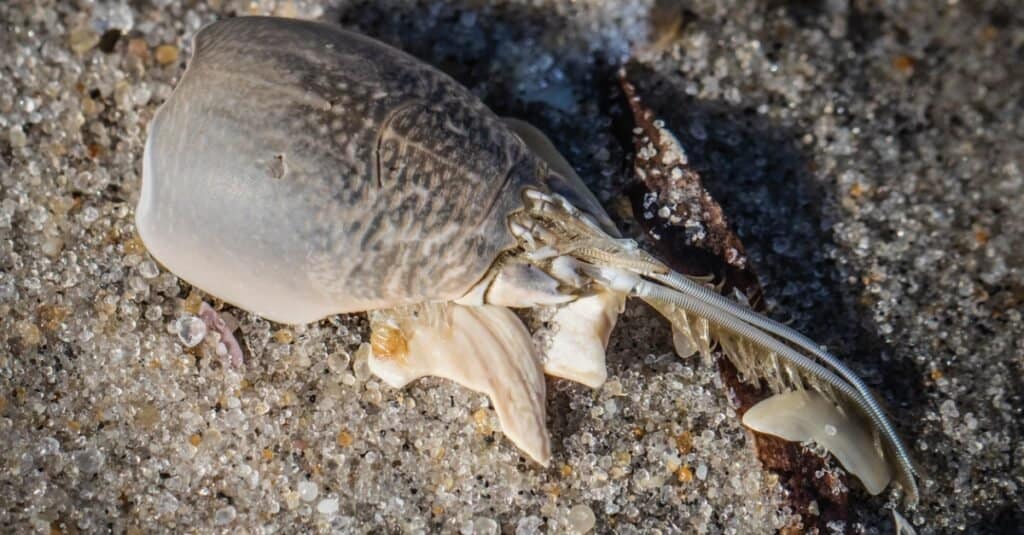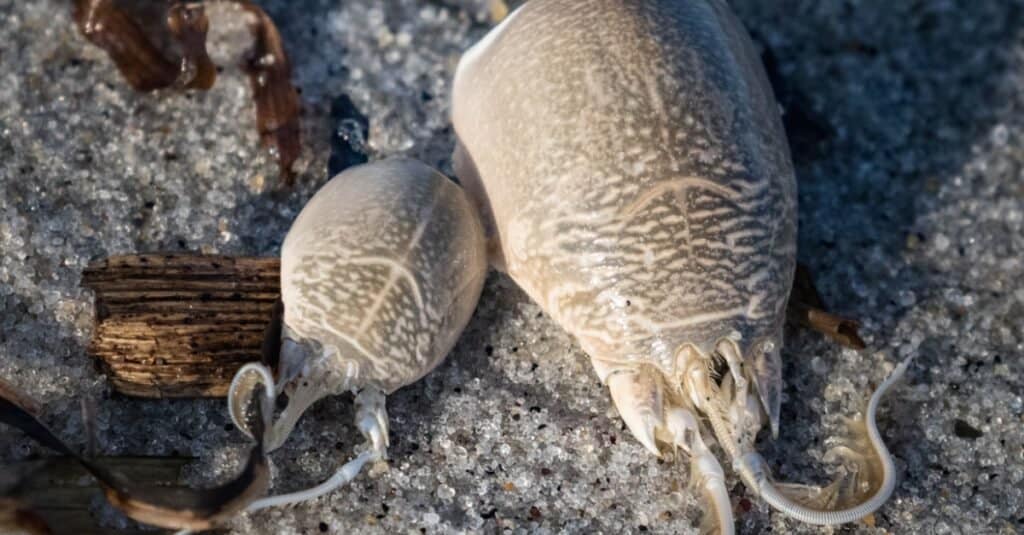Only about 2 inches long during its lifetime, the sand crab is a small but necessary beach dweller that you may or may not have seen. They burrow under the sand and eat a surprising number of things.
So, what do sand crabs eat? Sand crabs eat algae, plankton, mollusks, and other decaying animals.
But do sand crabs have any predators in their natural environment? And what impact can something as small as a sand crab have on its local ecosystem? Let’s learn about the sand crab now!
What Does a Sand Crab Eat?

.
©iStock.com/Cwieders
A sand crab eats microscopic plankton, mollusks, other smaller crabs, algae, and more. They are known as scavengers, and don’t often eat anything that isn’t easily accessible to them hiding in their sandy homes.
The American Midland Naturalist reports that sand crabs eat with their large, feathery antennae, poking them out of the sand to capture any potential food that recedes with the ocean tides.
Sand crabs also move up and down the beach or shoreline throughout the day to increase their food intake. They search for new locations in conjunction with the tide, so that they can maximize their feeding opportunities.
Given that most of this travel happens beneath the sand, you will likely not notice the sand crab hard at work. However, these little guys are driven by their stomachs, and you will no doubt notice their air bubbles poking up through the sand as tidewater and waves retreat!
A Complete List of 9 Foods Sand Crabs Eat
Sand crabs have been known to eat the following things:
- Algae
- Mollusks
- Plankton
- Other crabs
- Small fish
- Baby turtles
- Decomposing seabirds
- Decomposing mammals
- Foods left on beaches by humans
Given their scavenging nature, sand crabs will eat just about anything that is within their grasp from the safety of their sandy homes. This can mean that any number of foods will end up getting digested by the sand crab- not very different from regular crabs.
You could consider sand crabs omnivores for this reason. They are very opportunistic eaters, with strategy in mind when it comes to their daily feeding. Their ability to track the tides is only one of many cool facts about sand crabs.
According to the Oregon Marine Reserves, the sand crab is often used in neurological studies because it has the largest sensory neurons found in any animal. Just think- this tiny crab can benefit our research efforts too!

.
©iStock.com/EvolKitty
Do Sand Crabs Have Any Predators?
Sand crabs have a few predators, including the following:
- Seagulls
- Other sea birds
- Other varieties of birds
- Fish
- Other types of crabs
- Raccoons
- Humans (when used as bait)
There are many fish in the ocean that eat sand crabs as part of their daily diet. This is why many fishermen have taken to using sand crabs as their primary bait. For example, the barred surfperch, a type of fish, eats sand crabs almost exclusively!
Seagulls do a specific dance or shuffle with their feet in order to unearth sand crabs from the safety of their homes. Unless a sand crab can burrow back beneath the sand fast enough, they are likely to be eaten by seagulls.
According to The Wilson Journal of Ornithology, many mallard ducks are taking to eating sand crabs despite the potential risks to their stable diets. However, sand crabs are an excellent source of protein, so perhaps the benefits outweigh the risks!
Sand crabs do have the ability to avoid predators by burrowing quickly or swimming away backwards using their little legs. However, this is often not enough to save sand crabs from their fate.
This particular crustacean is also not known to survive more than two or three years in the wild. Their lifespan is short, and sand crabs can’t reproduce in the first year of their lives. However, should they survive, female sand crabs are capable of producing over 30,000 eggs in a year!
The Wilson Journal of Ornithology also mentions ravens as being a unique predator of the sand crab. Their research suggests that ravens are capable of sensing crabs that are carrying eggs, choosing to kill the crab but not consume it- eating only the eggs on the crab’s back.
Given that sand crabs mate and lay eggs during the spring and summer, you may see more birds attempting to feed on beaches and ocean shorelines during this time of year.
How Does Their Diet Impact Other Species?

Sand crabs do have the ability to avoid predators by burrowing quickly or swimming away backwards.
©iStock.com/Cwieders
Sand crabs can have a surprising impact on other species of crabs, fish, and birds. They are a unique and necessary part of any shoreline or ocean ecosystem, as very few creatures can survive on unprotected shorelines.
According to the Monterey Bay Aquarium, sand crabs often ingest domoic acid, a naturally occurring substance that has harmful results to creatures higher up on the food chain.
Should a bird, fish, or even a human eat a sand crab that has ingested high levels of this acid, poisoning can occur. Because of this, a sand crab’s diet has a great impact on the ecosystem around it and can be a useful resource for scientists.
Knowing how much domoic acid is present along a shoreline can be a useful tool in testing toxicity of local beaches. A sand crab is one of the main resources that scientists look to in order to test this acid.
Other than that, a sand crab’s diet doesn’t impact other species very much. Given that they are scavengers, these tiny guys often eat whatever they can get. They aren’t picky, though they are often picked off by predators!
The photo featured at the top of this post is © iStock.com/Cwieders
Thank you for reading! Have some feedback for us? Contact the AZ Animals editorial team.






